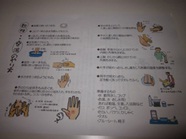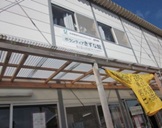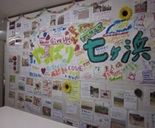I visited Tohoku area for three days from October 17th to 19th,
2011, and had a lot of precious opportunities to see the suffering people and
listen to their experiences.
Before my visit I had seen how it was going
in the disaster stricken areas through TV news, newspapers and the VfF website.
However, when I arrived there, I really realized that there were many things
which we were not able to understand only through the media. Especially, the
seaside towns still had fresh scars of the tsunami, even though more than half
a year had passed. I was really shocked by the scenes. I could not express my
feeling in words. I thought the least I could do was to burn the images into my
mind. During my visit, I accompanied the ashiyu
(foot bath) service provided by the NPO Rescue Stock Yard (RSY) and
Nippon Foundation Road Project in Watari town and Shichigahama town in Miyagi
Prefecture, which VfF has been reporting about on its website and tweets.
According to the Nippon Foundation Road Project website, the origin
of ashiyu as a disaster response
activity is as follows:
"Just after a disaster, many victims shiver with cold due to a
lack of heating, including stoves, because there is no kerosene, electricity or
gas. By taking ashiyu, they can keep
their bodies warm. Moreover, ashiyuis said to have the effect to reduce fatigue
of the whole body and stress of the victims. As it received a lot of attention in
the aftermath of the Niigata Chuetsu-oki Earthquake and the Noto Peninsula
Offing Earthquake, we decided to carry out this activity this time in Shichigahama.”
(Excerpt from the website of Nippon Foundation)

“Ashiyu Manual”
Originally in Shichigahama, water taken from a swimming pool was
used to flush the toilet. The ashiyuvolunteers boiled the water and used it for ashiyuinstead. I heard this was the beginning of ashiyuservice in Shichigahama. At the beginning, some evacuees criticized the
volunteers saying, “Why do they use the precious water for ashiyu?” However, the volunteers asked for their understanding by explaining
that they were going to reuse the water later to flush the toilet.
As most of the ashiyuvolunteers are not local residents, the evacuees seem to be able to speak out about
various things without hesitation and to lay their feelings bare. In addition,
as their feet become warm and the stiffness in their hands eases, they
gradually feel relaxed and speak openly. The volunteers said that when the
evacuees’ spoke in such a relaxed mood, they often expressed their most
pressing need, so it was important to pay attention and understand them. In
Shichigahama, some local junior high school students had also volunteered to
offer ashiyu services. As many
elderly people received ashiyu, it
happened that they saw their acquaintance among the ashiyu volunteers and would say, "Oh, you must be the grandchild
of my friend!" Ashiyu provided
them with an opportunity to get to know each other.
I believe that the "evacuees’ short comments or mutterings (tsubuyaki)" translated by VfF are true
reflections of victims’ voices coming from the bottom of their hearts. I want
to try to understand how the evacuees feel and continue to deliver their voices
to the world.
Through this visit, I realized that the local volunteers were able to answer the victims’
needs at the right time because they worked and stayed closely with the victims
through their activities, including ashiyu,
Ochanomi Café, and “TA-BE-SA-IN!” project, which we have introduced through the
VfF website.
Furthermore, their activities developed
opportunities for victims to get to know each other and are encouraging victims
to stand up on their own feet again. In addition, I learned that the needs for
volunteers are changing by each phase of the recovery process, and therefore,
volunteers have to be able to answer those needs in a timely manner. Actually, now that the shelters have been closed and victims have
moved to temporary housing, the volunteers’ role is entering into a new phase.
One of the most eye-opening things to me was that I was told there
is an appropriate time for volunteers to withdraw from the affected area to
allow local residents to take initiative in their recovery efforts. I also
learned that it is a very important work of the volunteer groups to build up a
system in which local residents will take over the activities of the
volunteers, such as ashiyu and social
meetings. I was moved because I had not thought about this from such a point of
view before. I felt, however, it was very difficult
to determine when they should withdraw and what support they should continue
because the victims need long-time support for their full recovery.
During this visit, it was a very valuable experience for me to get
to know other volunteers and have an opportunity to talk with them. I was moved
to see that each volunteer was always paying attention to improve their
activities. They will bring their experience back to their home town and inform
other people about their experience. I hope many people will be able to feel the
effects of this disaster more personally, to develop links of support, and
raise public awareness of disaster prevention.


“Kizuna-kan Volunteer Center”
“Project of
rediscovering local strengths”
・Final thoughts
A few days ago, the government finally determined its reconstruction
budget. I hope that it will be used to support the victims to stand up on their
own feet again.
In Rikuzen-takata, I had a chance to meet Ms. M. She lost her house
in the tsunami but she is very bright and positive despite of her difficulties.
She said, “Please continue to support Rikuzen-takata.” Her words carried weight
and were etched deeply in my mind.
During this visit, I also heard from other victims, “We want to do something!!” “We want to repay volunteers’
kindness.” According to newspapers, the affected people stood up and launched
their business in a temporary store. It will be a very long and difficult path toward
reconstruction, but I cannot help praying for the Tohoku area’s revival. In
addition, I reconfirmed the importance of connecting people, and the weight of
real voices during my visit. I want to act little by little thinking what I can
do with my head without forgetting what I felt.